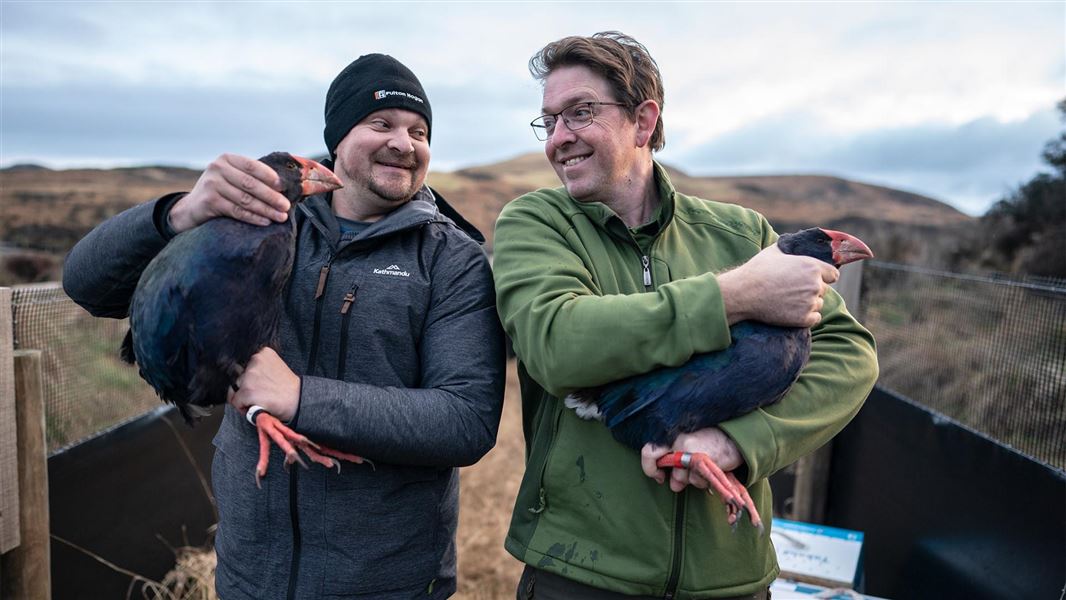Archived content: This media release was accurate on the date of publication.
Date: 09 July 2021
Fulton Hogan signed a partnership agreement with DOC in 2016 to support the Takahē Recovery Programme and it has seen DOC and Ngāi Tahu grow the overall takahē population from around 280 to around 450.
The taonga species also moved two steps along the threat classification system, from nationally critical to nationally vulnerable, in 2017 and a new wild population was started in Kahurangi National Park in 2018.
Fulton Hogan Managing Director Cos Bruyn and DOC Director-General Lou Sanson yesterday (Thursday 8 July) signed a renewed partnership agreement at Willowbank Wildlife Reserve in Christchurch. The occasion also celebrated the arrival of a new takahē pair - the aptly named Hogan and his mate Proteus - to start a takahē breeding programme at Willowbank.
“Fulton Hogan’s support has enabled the Takahē Recovery Programme to push new boundaries, most significantly in reintroducing takahē into Kahurangi National Park in a first attempt to establish a new wild population outside of Fiordland,” says Lou Sanson.
“Nearly half of all takahē are now living in the wild – in Kahurangi and in the takahē homeland in Fiordland’s Murchison Mountains. The search is now on to identify a suitable site with the right habitat and low predator numbers to establish a third wild population. These are pivotal steps towards the takahē recovery goal of having multiple self-sustaining wild populations in the South Island tussock lands that are the natural home of takahē.
“Critical to securing takahē from extinction has been developing a successful breeding blueprint that has led to breeding pair numbers increasing from 91 in 2015 to 141 now and the population growing at an average 8% a year.
“Restoration of nature is increasingly mainstream across the business community – increasingly just part of running a good business; Fulton Hogan’s leadership for takahē is an outstanding example.”
“We’re proud of our sponsorship of the takahe, to support the great work of DOC and Ngāi Tahu to secure the future of this unique New Zealand bird,” says Cos Bruyn.
“Being a part of the partnership and relocation of Hogan and Proteus today, means a lot to our people and we look forward to the ongoing success of this programme.”
Waihōpai Rūnaka Upoko Michael Skerrett says the future of this taonga species is much brighter, with the population increasing by 60 per cent over the past five years since the partnership with Fulton Hogan began.
“We’re very supportive of this mahi to save the takahē from extinction and establish new habitat for this manu to thrive. Together as a kaitiaki rōpu, we’re ensuring takahē will be around for future generations of New Zealanders – Kai mau te takahē mō ake tonu atu (The takahē will be around forever),” says Michael Skerrett.
“Takahē recovery is a collective effort,” says Lou Sanson. “Support also comes from the New Zealand Nature Fund, which assists the Takahē Recovery Programme with administration, advocacy and enabling donations. Teams at 18 island and mainland sanctuary sites across Aotearoa are providing safe breeding sites for takahē to help grow their numbers.
“Some great achievements in takahē recovery are being made but there’s more to do. Takahē sites are reaching capacity so we need to press on with establishing new wild populations. However, we currently can’t fully protect wild takahē from predators with available predator control tools.
“New Zealand’s work towards Predator Free 2050 and the development of new landscape-scale predator control tools is crucial for takahē being able to securely roam wild across their former natural range.”
Background information
- The four southern Ngāi Tahu papatipu rūnanga – Ōraka-Aparima, Waihōpai, Awarua and Hokonui – are part of the Takahē Recovery Programme.
- Takahē were traditionally a resource for Ngāi Tahu tīpuna/ancestors, who used feathers for weaving korowai/cloaks and kākahu/clothes. Bones were also likely used as needles and for making items.
Contact
For media enquiries contact:
Email: media@doc.govt.nz
